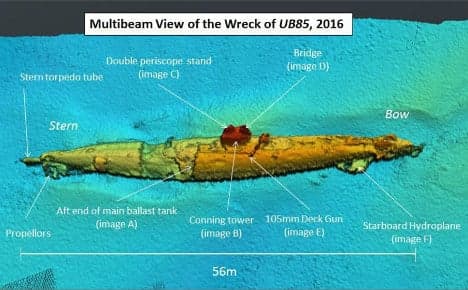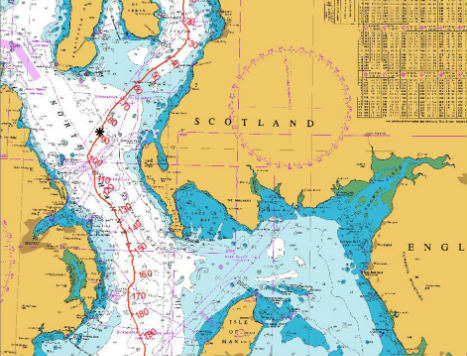Mysterious German U-boat wreckage found off Scotland

ScottishPower has uncovered the wreckage of a German U-boat from the First World War whilst laying subsea power cables.
Sonar images released by the Scotland-based energy company on Wednesday have identified a wreck on the sea floor, which experts have suggested may be the famous UB-85.
According to folklore, the crew of the submarine managed to fight off an attack from a sea monster, but the resulting damage forced them to surrender to a British Navy ship.
The legend goes that the U-boat captain, Günther Krech, described how a “beast” with “large eyes, set in a horny sort of skull [with] a small head, but with teeth that could be seen glistening in the moonlight" had attacked their craft.
“Every man on watch began firing a sidearm at the beast," he is believed to have said. “That is why you were able to catch us on the surface."
The crew of HMS Coreopsis was therefore amazed on April 30th 1918 when the enemy U-boat surrendered without resistance between the Scottish and Irish coasts.
 The black asterisk marks where the wreckage has been discovered. Photo: ScottishPower
The black asterisk marks where the wreckage has been discovered. Photo: ScottishPower
However, with a U-boat now discovered on the seabed, the truth behind the fate of the submarine may emerge from the depths.
Experts cannot be certain yet that it is the fabled submarine, but Innes McCartney, an historian and nautical archaeologist, said that “the features of this particular wreck, which is largely intact, confirm it as a UBIII-Class submarine.”
“We know of two [such submarines] which were lost in the area – the more famous UB-85 and its sister boat UB-82.”
Dr. McCartney favours a mechanical explanation for the U-boat’s inability to dive.
“We’re certainly closer to solving the so-called mystery of UB-85 and the reason behind it sinking - whether common mechanical failure or something that is less easily explained.”
However, some believe the fantastic tale to be equally probable.
“The area of sea where the attack took place has a history of sea monster sightings,” explained Gary Campbell, keeper of the Official Sightings Register of the Loch Ness Monster. “What the German captain said could well be true.”
“It’s great to see how Nessie’s saltwater cousin clearly got involved in helping with the war effort,” he continued.
Marine engineers working on a project with ScottishPower called Western Link came across the wreckage whilst laying a subsea marine cable that is going to stretch for 385 kilometres, making it the longest of its type in the world.
“In all the years I have been building power lines, I can say that this is the most extraordinary discovery,” said Peter Roper of ScottishPower.
It follows the discovery of another German First World War U-boat in January of this year, which was found by ScottishPower off the coast of Norfolk, east England.
Comments
See Also
Sonar images released by the Scotland-based energy company on Wednesday have identified a wreck on the sea floor, which experts have suggested may be the famous UB-85.
According to folklore, the crew of the submarine managed to fight off an attack from a sea monster, but the resulting damage forced them to surrender to a British Navy ship.
The legend goes that the U-boat captain, Günther Krech, described how a “beast” with “large eyes, set in a horny sort of skull [with] a small head, but with teeth that could be seen glistening in the moonlight" had attacked their craft.
“Every man on watch began firing a sidearm at the beast," he is believed to have said. “That is why you were able to catch us on the surface."
The crew of HMS Coreopsis was therefore amazed on April 30th 1918 when the enemy U-boat surrendered without resistance between the Scottish and Irish coasts.
 The black asterisk marks where the wreckage has been discovered. Photo: ScottishPower
The black asterisk marks where the wreckage has been discovered. Photo: ScottishPower
However, with a U-boat now discovered on the seabed, the truth behind the fate of the submarine may emerge from the depths.
Experts cannot be certain yet that it is the fabled submarine, but Innes McCartney, an historian and nautical archaeologist, said that “the features of this particular wreck, which is largely intact, confirm it as a UBIII-Class submarine.”
“We know of two [such submarines] which were lost in the area – the more famous UB-85 and its sister boat UB-82.”
Dr. McCartney favours a mechanical explanation for the U-boat’s inability to dive.
“We’re certainly closer to solving the so-called mystery of UB-85 and the reason behind it sinking - whether common mechanical failure or something that is less easily explained.”
However, some believe the fantastic tale to be equally probable.
“The area of sea where the attack took place has a history of sea monster sightings,” explained Gary Campbell, keeper of the Official Sightings Register of the Loch Ness Monster. “What the German captain said could well be true.”
“It’s great to see how Nessie’s saltwater cousin clearly got involved in helping with the war effort,” he continued.
Marine engineers working on a project with ScottishPower called Western Link came across the wreckage whilst laying a subsea marine cable that is going to stretch for 385 kilometres, making it the longest of its type in the world.
“In all the years I have been building power lines, I can say that this is the most extraordinary discovery,” said Peter Roper of ScottishPower.
It follows the discovery of another German First World War U-boat in January of this year, which was found by ScottishPower off the coast of Norfolk, east England.
Join the conversation in our comments section below. Share your own views and experience and if you have a question or suggestion for our journalists then email us at [email protected].
Please keep comments civil, constructive and on topic – and make sure to read our terms of use before getting involved.
Please log in here to leave a comment.